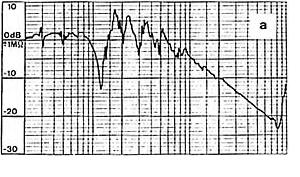
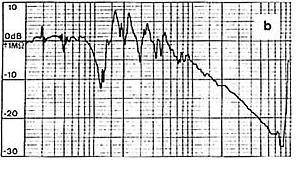
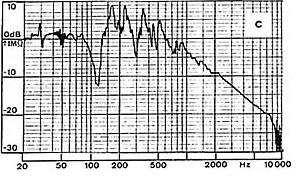
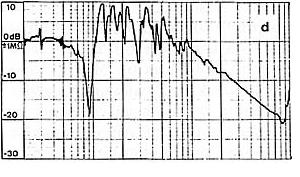
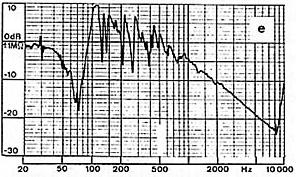

[<- Previous] [Contents of this lecture] [Next ->]
In experimental work with upright pianos, a complete assembly of the instrument is normally used. Such an assembly consists of the wooden frame, soundboard, and metal plate, including the strings tuned to nominal pitch. This means that the soundboard is under the same load as in the finished piano. However, great care must be taken to ensure that the strings are muted so they cannot vibrate during the measurements. For this purpose, narrow strips of felt are woven through the strings as mentioned above. This operation wastes valuable time, and the question therefore arose as to whether the experiments could be conducted on a soundboard without strings, or at least with the tension brought down, without seriously changing the results.
To answer this question, measurements were conducted on a completely strung assembly of an upright piano for which the pitches were successively lowered (A4 = 440, 415, 220, and 0 Hz). Finally, the strings were removed altogether. By these changes, the load on the soundboard was progressively reduced to zero, which would change the bending stiffness of the soundboard. When the strings were removed, the vibrating mass was also changed. Plate theory tells us that both the magnitude of the impedance, as well as the resonance frequencies will change when these parameters are changed.
The experiments showed that detuning the strings by a semitone, or even an octave, produces only a small change in bending stiffness. This can be seen in the impedance curves for the first three conditions, which are practically identical (see Fig. 7). Not until the tension was completely let down could an influence on the impedance curve be observed (Fig. 7 d). In the lower frequency region, the soundboard resonances were shifted downward. The lowest resonance (leftmost valley on the Z-curve) was shifted from 115 to 90 Hz when the string tension was let down completely, while the resonances above 200 Hz remained essentially uninfluenced.
Fig. 7. Influence of string tension on the input impedance (MP 7):
(a) Normal tuning (A4 = 440 Hz),
(b) a semitone lower (A4 = 415 Hz),
(c) an octave lower (A4 = 220 Hz),
(d) slack strings, and
(e) strings removed.





When the strings were completely removed, the lowest resonance was shifted further downward (to 70 Hz), and now the upper resonances were also lowered (Fig. 7 e). However, the general configuration of the impedance curve remained practically unchanged.
The sound radiation curves show a somewhat different picture. Above approximately 1000 Hz the sound radiation does not change to any appreciable degree - the changes are evident only in the middle and lower frequency regions. Again, the general configuration of the curve remains practically unchanged.
Summing up, stringing the back and tuning the strings to playing pitch are not absolutely necessary for obtaining representative measurements of the properties of a soundboard. The basic characteristics of the impedance and sound radiation curves remain essentially unaffected when the string load is removed. Only the lower resonances are influenced, resulting in an upward shift of about 50 Hz when the strings are pulled up to pitch. This can, however, easily be taken into account when analyzing the data.
[<- Previous] [Top] [Contents of this lecture] [Next ->]
This lecture is one of Five lectures on the Acoustics of the piano
© 1990 Royal Swedish Academy of Music